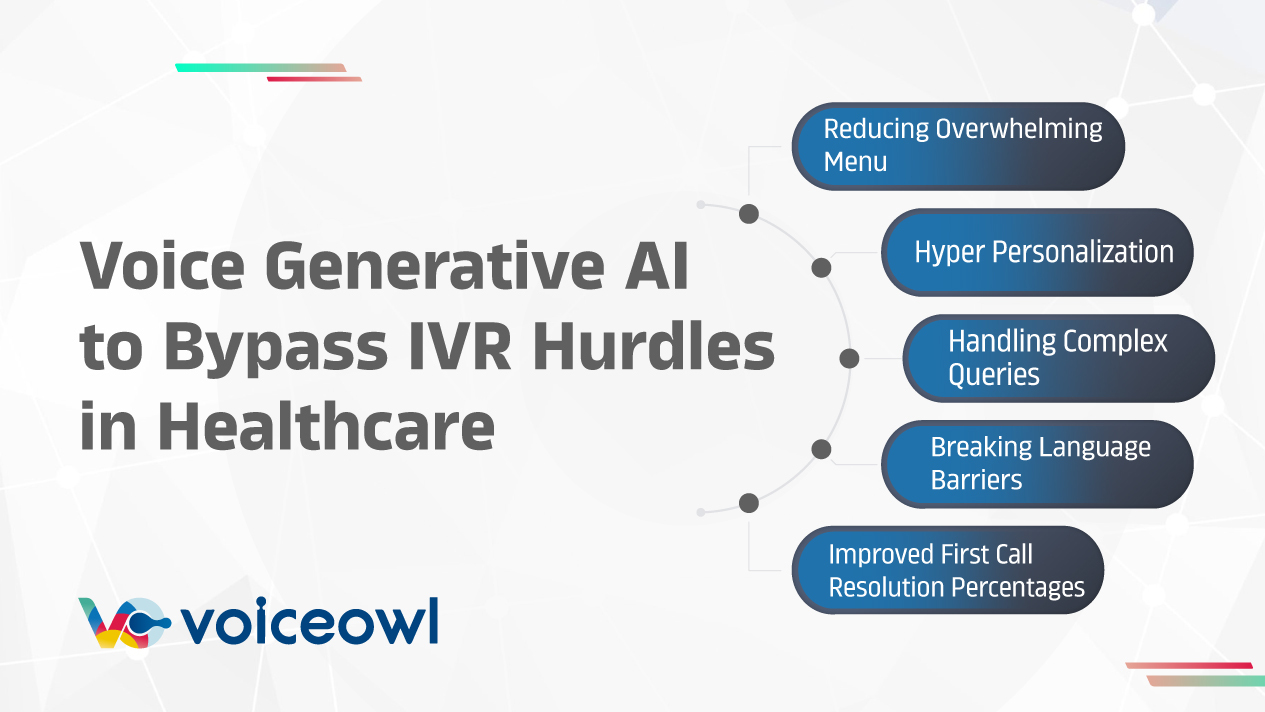A 2023 survey found that 70% of healthcare organizations saw voice AI as helpful for improving their workflows and patient care.
One big reason? Contact center IVR systems, while functional, often fall short in addressing consumer needs effectively.
But on the other hand, voice-generative AI is emerging as a groundbreaking solution. Let’s see how…
Reducing Overwhelming Menu
Traditional IVR systems often present a maze of menus, which can be overwhelming for patients. This is particularly true during critical moments. This complexity leads to increased call abandonment rates and patient frustration.
Voice-generative AI in healthcare uses sophisticated NLP and deep learning. It helps your AI agent understand and manage intricate queries. The context-aware model maintains the flow of multi-turn conversations. This helps in interpreting complex medical questions accurately.
The system analyzes patient inputs for context, urgency, and medical relevance. This allows it to generate precise and detailed responses.
You can imagine AI agents answering complex health concerns without error.
This approach minimizes the need for live agent involvement. And, it also significantly reduces patient wait times by efficiently resolving complex queries.
Hyper Personalization
Contact center IVR systems operate on fixed scripts and predefined paths. What they lack is the capability to access or analyze patient-specific data.
This one-size-fits-all approach fails to tailor interactions to individual medical histories or preferences. As a result, patients receive generic responses. Many times, they don’t address their unique health concerns or needs effectively.
Whereas a system with voice-generative AI integrates with Electronic Health Records (EHRs).
This includes medical history and treatment preferences. It allows the AI to tailor responses based on individual patient profiles. So it enables more relevant and personalized interactions than contact system IVRs.
Handling Complex Queries
IVR systems are optimized for simple tasks such as appointment scheduling or prescription refills. But the main thing they lack is the capability to manage complex or nuanced queries.
These systems often fail to resolve intricate issues. Result? Frequent call transfers to live agents. This leads to extended wait times. The IVR system’s limited functionality needs human intervention for resolution.
Voice-generative AI has advanced conversational capabilities. It uses NLP to understand context and intent. It’s knowledge and intuition allow it to handle multi-turn conversations and provide detailed, accurate explanations.
This capability reduces the need for live agents by efficiently shortening patient wait times.
Language and Accessibility Barriers
Limited language support by IVRs lacks features for accessibility. This poses challenges for patients from diverse backgrounds or those with disabilities. These barriers can impede effective communication and service access.
Some voice-gen AI platforms, like VoiceOwl, support 135 languages and dialects. This makes it inclusive for a broad patient demographic. This ensures that patients with different linguistic and accessibility requirements receive equitable support.
Longer Hold Times
Traditional IVR systems often cause extended hold times. This is due to their limited query handling capabilities. They rely on static menu trees and predefined responses. This can delay the resolution of complex issues. These delays are compounded by the time patients spend on multiple menu layers or waiting for agents.
And due to Natural Language Processing (NLP) and conversational models, they process and resolve complex queries smoothly.
Gen-AI provides accurate responses in real-time. This significantly reduces the need for patients to wait on hold or escalate issues to live agents.
Improved First Call Resolution Percentages
IVR systems have lower first call resolution rates as they don’t manage multifaceted or nuanced queries well. They are designed for basic tasks and typically require escalation to human agents for more complex issues. This leads to increased call volume and extended resolution times.
By deep learning and context-aware NLP, complex queries during the initial call can be addressed.
This capability allows the AI to handle a broader range of issues without necessitating call transfers. This, thereby increasing the efficiency and effectiveness of the resolution process.
Cut VR Downtime
Voice Response (VR) systems can experience downtime due to hardware or software failures. This affects their availability and reliability. Such interruptions can disrupt service and lead to delays in processing patient interactions. And this impacts overall service quality.
Voice-generative AI systems are built on scalable cloud-based infrastructures. These infrastructures have high redundancy and failover mechanisms. Continuous monitoring and automated diagnostics ensure minimal downtime and quick recovery from potential issues. This maintains consistent service availability and reliability in your contact center.
Reduce High Transfer Rates
Approximately 72% of customers view interacting with multiple agents as indicative of poor customer service. Contact center IVR systems often lead to high transfer rates because they are typically limited to handling basic queries. They even need frequent escalation to human agents for complex issues. This results in inefficient patient interactions and fragmented service experiences.
To manage more and more queries, voice-generative AI minimizes transfer rates by employing customized algorithms with adaptive learning. Its ability to provide detailed, contextually relevant responses within a single interaction reduces the need for transferring calls to multiple agents. This, by default, streamlines the process and improves service continuity.
The Right Voice Gen-AI platform?
When it comes to healthcare, ensuring compliance, seamless integration, and glitch-free operations is crucial for customer-facing agents. That’s why you need an AI solution that not only reduces costs but also guarantees efficiency and peace of mind. With VoiceOwl’s customized LLM models and multi-agent technologies, you get top-notch latency and tailored solutions. Let’s talk about how VoiceOwl can transform your contact center experience!

